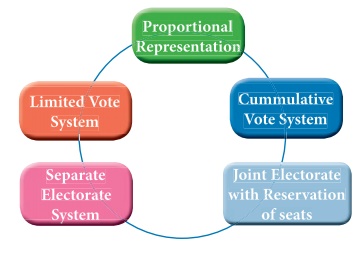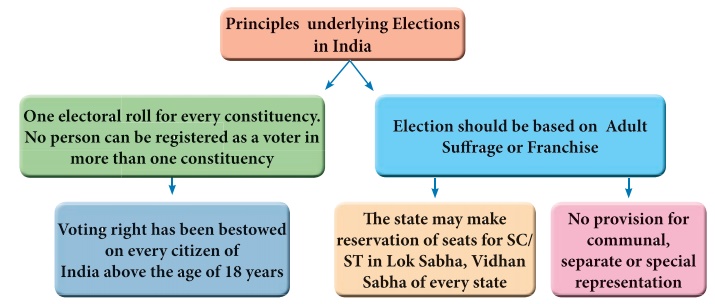Political Science - Types of Representation/ Reservation of Constituencies | 11th Political Science : Chapter 10 : Election and Representation
Chapter: 11th Political Science : Chapter 10 : Election and Representation
Types of Representation/ Reservation of Constituencies
Types of Representation/ Reservation of Constituencies
Election Systems-Plurality/Majority Systems
What are Plurality / Majority Systems? The
principle of plurality/ majority system is simple. After votes have been cast
and totalled, those candidates or parties with the most votes are declared the
winners. However, the way this is achieved in practice varies widely. Five
types of plurality/majority systems can be identified.
A.
First Past The Post (FPTP)
B.
Block Vote(BV)
C.
Party Block Vote(PBV)
D.
Alternative Vote(AV)
E.
Two-Round Systems(TRS)
A. First Past The Post (FPTP)
The First Past The Post system is the simplest form
of plurality/majority system, using single member districts and
candidate-centered voting. FTPT systems are found primarily in the UK and those
countries historically influenced by Britain. Along with the UK, the other
countries are Canada, India and the USA. FPTP is also used by a number of
Caribbean countries, Bangladesh, Burma, India, Malaysia, Nepal and small island
countries of the South Pacific.
B. Block Vote (BV)
The Block –Vote is common in countries with weak or
non -existent political parties. The Cayman Islands, The Falkland Islands,
Guernsey, Kuwait, Laos, Lebanon, the Maldives, Palestine, the Syrian Arab
Republic etc use Block Vote electoral systems.
The Block Vote is often applauded for retaining the
voter’s ability to vote for individual candidates and allowing for
reasonably-organized geographical districts while at the same time, increasing
the role of political parties compared with FPTP and strengthening those
parties which demonstrate most coherence and organizational structure.
C. Party Block Vote (PBV)
PBV is simple to use, encourages strong parties and
allows for parties to put up mixed slates of candidates in order to facilitate
minority representation. It can be used to help to ensure balanced ethnic
representation. Dijibouti, Singapore, Senegal, Tunisia use the PBV method.
D. The Alternative Vote (AV)
This system enables voters to express their
preferences between candidates rather than simply their first choice. Hence it
is known as ‘Preferential Voting’. AV is used in Australia, Fiji and Papua
Guinea. By transferring ballots, it enables the votes of several candidates to
accumulate, so that diverse but related interests can be combined to win
representation.
E. The Two- Round System (TRS)
The central feature of the Two-Round System is as
the name suggests: it is not one election but takes place in two rounds, often
a week or a fortnight apart. This system is used to elect national legislatures
and are most common methods used worldwide for the direct election of
Presidents. TRS is used by the Central African Republic, Congo, Gabon, Mali,
Mauritania, Haiti, Iran, Vietnam, Tajikistan, Uzbekistan etc.
Various Methods Of Minority Representation

Is it good to have political competition?
Elections are all about political competition. This competition takes various forms. The most obvious form is the competition among political parties. At the constituency level, it takes the form of competition among several candidates. If there is no competition, elections will become pointless. Though an electoral competition leads to a sense of disunity and factionalism in every locality, regular electoral competition provides incentives to political parties and leaders. They know that if they raise issues that people want to raise, their popularity and chances of victory will increase in the next elections. But if they fail to satisfy the voters with their work they will not be able to win again.
What is our system of Elections?
Can we say that Indian elections are democratic? To
answer this question, let us take a look at how elections are held regularly
after every five years. After five years the term of all the elected
representatives comes to an end. The Lok Sabha or Vidhan Sabha stands
dissolved. Elections are held in all the constituencies at the same time,
either on the same day or within a few days. This is called a general election.
Sometimes election is held only for one constituency to fill the vacancy caused
by death or resignation of a member. This is called By–Election.
Electoral Constituencies
You would have heard about the people of Tamilnadu
electing 39 lok sabha MPs. You may have wondered how they did that. Did every
person in Tamilnadu vote for all the 39 MPs? You perhaps know that this is not
the case. In our country we follow an area based system of representation. The
country is divided into different areas for the purpose of elections. These
areas are called Electoral Constituencies. The voters who live in an area elect
one representative.
For Lok sabha elections, the country is divided
into 543 constituencies. The representative elected from each constituency is
called a member of Parliament or an MP. One of the features of a democratic
election is that every vote should have equal value. That is why our
constitution requires that each constituency should have a roughly equal
population within it. Similarly each state is divided into a specific number of
assembly constituencies. In this case the elected representative is called the
Member of Legislative Assembly or a MLA. Each Parliamentary constituency has
within itself several assembly constituencies. The same principle applies for
Panchayat and Municipal elections. Each village or town is divided into wards
that are like constituencies. Each ward elects one member of the village or the
urban local body. Sometimes these constituencies are counted as Seats, for each
constituency represents one seat in the assembly.
Reserved Constituencies
Our Constitution entitles every citizen to elect
its representative and to be elected as a representative. In an open electoral
competition, certain weaker sections may not stand a good chance to get elected
to the Lok Sabha and the State Legislative Assemblies. They may not have the
required resources, education and contacts to contest and win elections against
others.If that happens our Parliament and Assemblies would be deprived of a
significant section of our population. That would make our democracy less representative
and less democratic.
So, the makers of our Constitution thought of
special system of reserved constituencies for the weaker sections. Some
constituencies are reserved for the people who belong to the Scheduled Castes
(SC) and Scheduled Tribes (ST). This system of reservation was extended later
on to other weaker sections at the district and local levels.
Delimitation
The division of each state into as many
constituencies as in the Loksabha from that state and State Legislative
Assemblies is done primarily on the basis of population census. As far as
practicable, geographical area of constituencies were to be delimited taking
into account physical features, existing boundaries of administrative units,
facilities of communication and public convenience.
Delimitation Acts
First Delimitation Commission Act, 1952 Second
Delimitation Commission Act, 1963 Third Delimitation Act,1973 Fourth
Delimitation Act, 2002.
Voters’ List
Once the constituencies are decided, the next step
is to decide who can and who cannot vote. This decision cannot be left to
anyone till the last day. In a democratic election, the list of those who are
eligible to vote is prepared much before the election and given to everyone.
This list is officially called the Electoral Roll or the Voters’ List.
This is an important step for, it is linked to the
first condition of democratic election that everyone should get an equal
opportunity to choose representatives irrespective of differences.
In our country, all the citizens aged 18 years and above can vote in an
election. Every citizen has the right to vote, regardless of his or her caste,
religion or gender.
It is the responsibility of the government to get the names of all eligible voters put on the voters’ list. Names of those who move out of the place or those who are dead are deleted. A complete revision of list takes place every five years. In the last few years, a new system of Electoral Photo Identity Card (EPIC) has been introduced. The voters are required to carry this card when they go out to vote. Not compulsory, for voting, the voters can show many other proofs like the Aadhar Card, Ration card or Driving License.
Electoral Process In India
Delimitation of Constituencies
Notification of the Election
Notification by the Election Commission regarding
Nomination and withdrawal
Filing of nomination papers by the intending
candidates
Verification and the acceptance or rejection of
the nomination papers
Election campaign
Polling process
Countingofvotesandannouncement of Election
Results
Provisions Regarding Elections in India

Nomination of Candidates
In a democratic election the people should have a real choice. This
happens only when there are no restrictions on anyone to contest an election.
This is what our system provides. Anyone who can be a voter can also become a
candidate in the elections. The only difference is that in order to be a
candidate, the minimum age is 25 years, while it is only 18 years for being a
voter. Political parties nominate their candidates who get the party symbol and
support. Party’s nomination is often called as party ‘ticket’.
Every person who wishes to fill a ‘nomination form’
has to give some money as security deposit. According to the direction of the
Supreme Court, every candidate has to make a legal declaration, giving full
details of:
·
Serious criminal cases pending against the
candidate
·
Details of the assets and liabilities of the
candidate and his or her family
·
Educational qualifications of the candidate
This information has to be made public. This
provides an opportunity to the voters to make their decision on the basis of
the information provided by the candidates.
Election Campaign
The main purpose of election is to give people a
chance to choose the representatives, the government and the policies they
prefer. Therefore it is necessary to have a free and open discussion about who
is a better representative, which party will make a better government or what
is a good policy. This is what happens during election campaigns.
In our country such campaigns take place for a two week period between
the announcement of the final list of candidates and the date of polling.
During this period the candidates approach their voters, political leaders
address election meetings and political parties mobilise their supporters. This
is also the period when newspapers, social media, televisions are full of
election related stories and debates. Election campaign is not limited to these
two weeks only. Political parties start preparing for elections months before
they actually take place.
In election campaigns, political parties try to focus public attention
on some big issues. They want to attract the public to that issue and get them
vote for their party on that basis. In a democracy it is best to leave
political parties and candidates free to conduct their election campaigns the
way they want to. But it is sometimes necessary to regulate campaigns to ensure
that every political party and candidate gets a fair and equal chance to
compete.
According to our election law, no party or candidate can:
v Bribe or
threaten voters
v Appeal to
them in the name of caste or religion
v Use
government resources for election campaign
If they do so, their election can be rejected by the court even after
they have been declared elected. In addition to the laws, all the political
parties in our country have agreed to a model Code of Conduct for election
campaigns. According to this no party or candidate can:
·
Use any place of worship for election propaganda
·
Use government vehicles, aircrafts and officials
for elections
·
Once elections are announced, Ministers shall not
lay foundation stones of any projects, take any big policy decisions or make
any promises of providing public facilities.
Related Topics